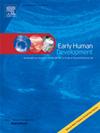Prevalence and risk factors for neurodevelopmental impairment in very preterm infants without severe intraventricular hemorrhage or periventricular leukomalacia
IF 2
3区 医学
Q2 OBSTETRICS & GYNECOLOGY
引用次数: 0
Abstract
Objectives
To review the prevalence and risk factors for severe neurodevelopmental impairment (NDI) in infants born at 22–29 weeks of gestation without severe intraventricular hemorrhage (IVH) or periventricular leukomalacia (PVL).
Study design
This single-centered retrospective cohort study enrolled infants born at 22–29 weeks of gestation treated at Saitama Medical Center, Saitama Medical University, from 2005 to 2020. Patients with severe IVH or PVL were excluded. The primary outcome was severe NDI at 3 years of age, defined by the presence of neurodevelopmental delay (developmental quotient <70), severe cerebral palsy, or severe sensory deficit. The incidence of severe NDI was assessed, and its associated risk factors were analyzed using multivariable logistic regression.
Results
A total of 666 patients were analyzed, including 134 (20 %) who developed severe NDI. The prevalence of severe NDI was high among infants born at 22 weeks (19/26, 73 %) and 23 weeks (17/50, 34 %) of gestation. A multivariable logistic regression analysis with previously known predictors showed that lower birth weight, male sex, no antenatal corticosteroid therapy, and abdominal surgery were independently associated with severe NDI at 3 years of age.
Conclusions
As shown in previous studies, a high prevalence of severe NDI was observed in our cohort. Infants born at 22 and 23 weeks of gestation have a high risk of severe NDI even though they are without severe IVH or PVL. Antenatal corticosteroid therapy were beneficial for preventing severe NDI. Infants with a history of abdominal surgery require close monitoring for their neurodevelopmental outcomes.
无严重脑室内出血或脑室周围白质软化的极早产儿神经发育障碍的患病率和危险因素
目的探讨妊娠22-29周出生的无严重脑室内出血(IVH)或脑室周围白质软化(PVL)的婴儿发生严重神经发育障碍(NDI)的发生率及危险因素。研究设计:本单中心回顾性队列研究纳入2005年至2020年在埼玉医科大学埼玉医学中心治疗的22-29周出生的婴儿。排除严重IVH或PVL患者。主要结局是3岁时出现严重NDI,表现为神经发育迟缓(发育商70)、严重脑瘫或严重感觉缺陷。评估严重NDI的发生率,并使用多变量logistic回归分析其相关危险因素。结果共分析666例患者,其中重度NDI 134例(20%)。重度NDI患病率在妊娠22周(19/ 26,73 %)和23周(17/ 50,34 %)出生的婴儿中较高。一项多变量logistic回归分析显示,低出生体重、男性、产前未接受皮质类固醇治疗和腹部手术与3岁时严重NDI独立相关。结论与之前的研究一样,我们的队列中观察到严重NDI的高患病率。在妊娠22周和23周出生的婴儿即使没有严重的IVH或PVL,也有严重NDI的高风险。产前皮质类固醇治疗有利于预防严重的NDI。有腹部手术史的婴儿需要密切监测他们的神经发育结果。
本文章由计算机程序翻译,如有差异,请以英文原文为准。
求助全文
约1分钟内获得全文
求助全文
来源期刊

Early human development
医学-妇产科学
CiteScore
4.40
自引率
4.00%
发文量
100
审稿时长
46 days
期刊介绍:
Established as an authoritative, highly cited voice on early human development, Early Human Development provides a unique opportunity for researchers and clinicians to bridge the communication gap between disciplines. Creating a forum for the productive exchange of ideas concerning early human growth and development, the journal publishes original research and clinical papers with particular emphasis on the continuum between fetal life and the perinatal period; aspects of postnatal growth influenced by early events; and the safeguarding of the quality of human survival.
The first comprehensive and interdisciplinary journal in this area of growing importance, Early Human Development offers pertinent contributions to the following subject areas:
Fetology; perinatology; pediatrics; growth and development; obstetrics; reproduction and fertility; epidemiology; behavioural sciences; nutrition and metabolism; teratology; neurology; brain biology; developmental psychology and screening.
 求助内容:
求助内容: 应助结果提醒方式:
应助结果提醒方式:


